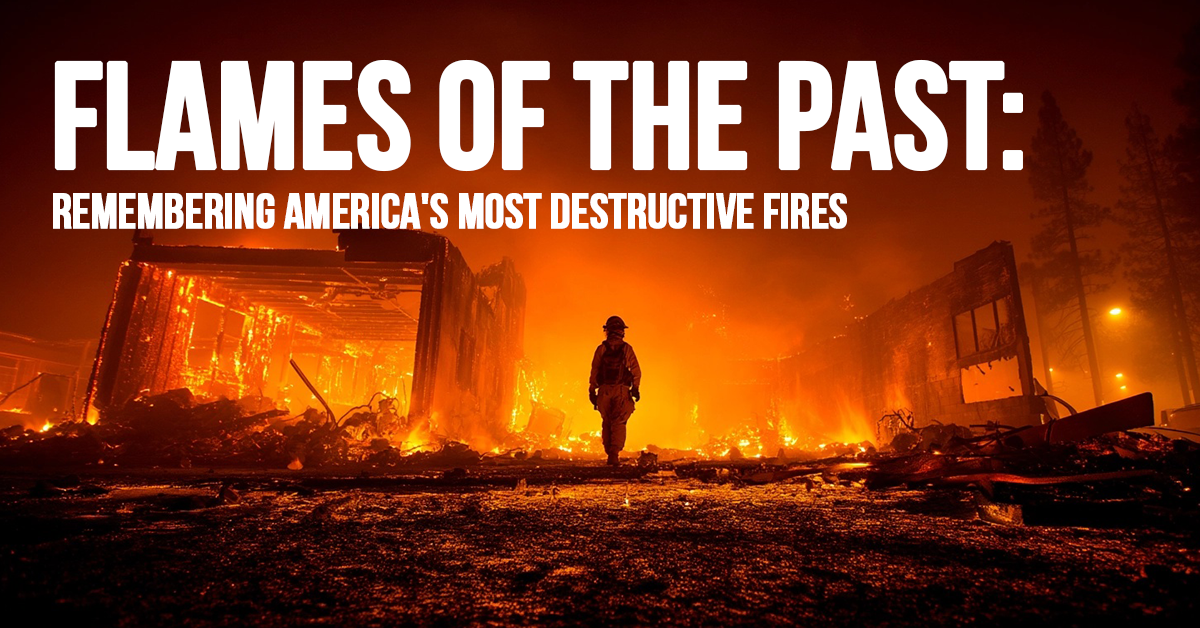Flames of the Past: Remembering America’s Most Destructive Fires

Flames of the Past: Remembering America’s Most Destructive Fires
House fires, though still a significant threat, are far less devastating than they once were. While modern firefighting technology and building codes have dramatically reduced the scale of destruction, history is filled with harrowing tales of fires that consumed entire cities and claimed countless lives. In the 1800s, with wooden structures packed closely together and limited firefighting capabilities, even small fires could quickly escalate into raging infernos.
Before the advent of widespread telephone access, public call boxes served as the primary means of alerting fire departments. Rural and forest fires posed an even greater challenge, often burning unchecked for extended periods before being detected. Let’s explore some of the most catastrophic fires that have scarred the American landscape.
The Peshtigo Fire (1871): A Forgotten Catastrophe
Often overshadowed by the Great Chicago Fire, which occurred on the same day, the Peshtigo Fire remains one of the most devastating wildfires in U.S. history. On October 8, 1871, a massive forest fire ignited in northeastern Wisconsin, eventually spreading to the Upper Peninsula of Michigan. This inferno consumed a staggering 1.2 million acres and claimed an estimated 1,500 to 2,500 lives, making it the deadliest fire in American history. The sheer scale of the Peshtigo Fire, with its death toll nearly matching today’s annual fire-related fatalities, is a stark reminder of the destructive power of nature.
The Great Fire of New York (1776 & 1835): Urban Devastation
New York City has experienced its share of devastating fires. The first Great Fire of New York occurred on September 20, 1776, during the American Revolutionary War. The fire, which raged for two days, consumed approximately 25% of the city’s buildings in Lower Manhattan. Decades later, in 1835, another “Great New York Fire” struck the city, causing widespread destruction. These fires highlight the vulnerability of densely populated urban areas to fire hazards.
The San Francisco Fire (1906): Earthquake and Inferno
One of the most iconic fires in American history was the result of the devastating San Francisco earthquake of 1906. On April 18, the earthquake triggered numerous fires that swept through the city, causing unimaginable damage and loss of life. The combined impact of the earthquake and fire is estimated to have resulted in 700 to 3,000 or more deaths. The San Francisco Fire stands as a testament to the destructive power of natural disasters and the importance of preparedness.
Homeowners Insurance: Protecting Against Fire Damage
While the scale of fires has decreased significantly, they still pose a considerable threat to homeowners. Homeowners insurance plays a crucial role in protecting against the financial devastation of fire damage. It’s essential to ensure your policy provides adequate coverage for your home and belongings.
Key Components of Fire Coverage:
- Dwelling Coverage: Protects the structure of your home.
- Personal Property Coverage: Covers your belongings, such as furniture, electronics, and clothing.
- Additional Living Expenses (ALE): Helps pay for temporary housing and living expenses if your home is uninhabitable.
Conclusion:
The historic fires recounted in this article serve as a reminder of the ever present danger of fire. By ensuring your property is adequately covered by homeowners insurance, and by practicing fire safety, you can help protect yourself from the devastation of fire damage.
Disclaimer: This article provides general information and should not be considered professional insurance or fire safety advice.



